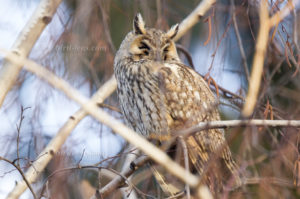 In a small side street of the sleepy town of Balmazújváros in eastern Hungary, almost in the city center next to the church, up to 10 Long-eared Owl (Asio otus) have been hiding in large trees for years. A bizarre sight that makes every photographer or birdwatcher’s heart beat faster. Long-eared Owls are not uncommon in almost any countryside in Europe. However, they are difficult to observe outside winter time. They usually sleep during the day and only become active during the pitch-dark night.
In a small side street of the sleepy town of Balmazújváros in eastern Hungary, almost in the city center next to the church, up to 10 Long-eared Owl (Asio otus) have been hiding in large trees for years. A bizarre sight that makes every photographer or birdwatcher’s heart beat faster. Long-eared Owls are not uncommon in almost any countryside in Europe. However, they are difficult to observe outside winter time. They usually sleep during the day and only become active during the pitch-dark night.
The ecological requirements of the Long-eared Owl largely coincide with those of the Eurasian Kestrel (Falco tinnunculus), the Eurasian Magpie (Pica pica) and the Carrion Crow (Corvus corone). The two latter are also the most important nest suppliers, as Long-eared Owls themselves do not build nests.
In winter, Long-eared Owls concentrate in the vicinity of particularly nutritious habitats with high vole densities or mass sleeping places of small birds. Some wintering sites have been regularly visited by dozens to more than 100 Long-eared Owls for years, not infrequently also in cemeteries and parks with a good food supply.
What drives this rather large number of long-eared owls to set up quarters exactly here will probably remain their secret. The choice of location does not mean that they have to settle for a lot of traffic noise and a lot of people, but of course one or the other curious person passes by. But people are peaceful and only look up from time to time. This brings significant benefits for the photographer. The owls are accustomed to human beings.
One morning we drive past the church and we have already seen the first long-eared owls in a garden (in a conifer tree). But the best is a largely free-standing long-eared owl directly in a birch on the small side street. It is a bit tricky, because the branches of the birch are always hanging in front of the long-eared owl and irritate the autofocus of the camera. But since the morning sun is coming out right now, a few really nice pictures of the owl are successful. Others sit in spruces in a garden. The owls in the side street obviously did not feel disturbed by the presence of humans. Therefore, I can spend some time with them and shoot some nice pictures. Long-eared owls can be recognized quickly if they feel annoyed: they pinch their eyes and show a very narrow posture. In the pictures is always a little pinched and a relaxed posture to see.
Geese occasionally pull over me. So I can see a group of long-tailed geese (Anser albifrons) of the subspecies flavirostris fly over me.
To cope with the growing demand for top shots of the rarer species of the Palearctic Bird-Lens is keen to enrich the range of pictures of birds you can find in the western Palearctic. Trips to different places like this one to capture images of rare birds of western Palearctic were very successful. The nice images you find in the gallery are only a first impression, what you will find in the gallery in the “Picture Shop” very soon. Just give me a message, if bird-lens.com could serve you with an image needed before the new pictures are online.
Other successful shootings you can see under: www.bird-lens.com in the pictures shop.